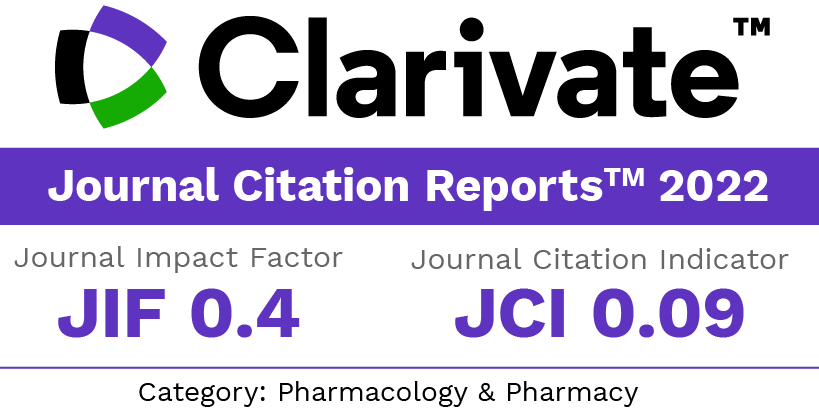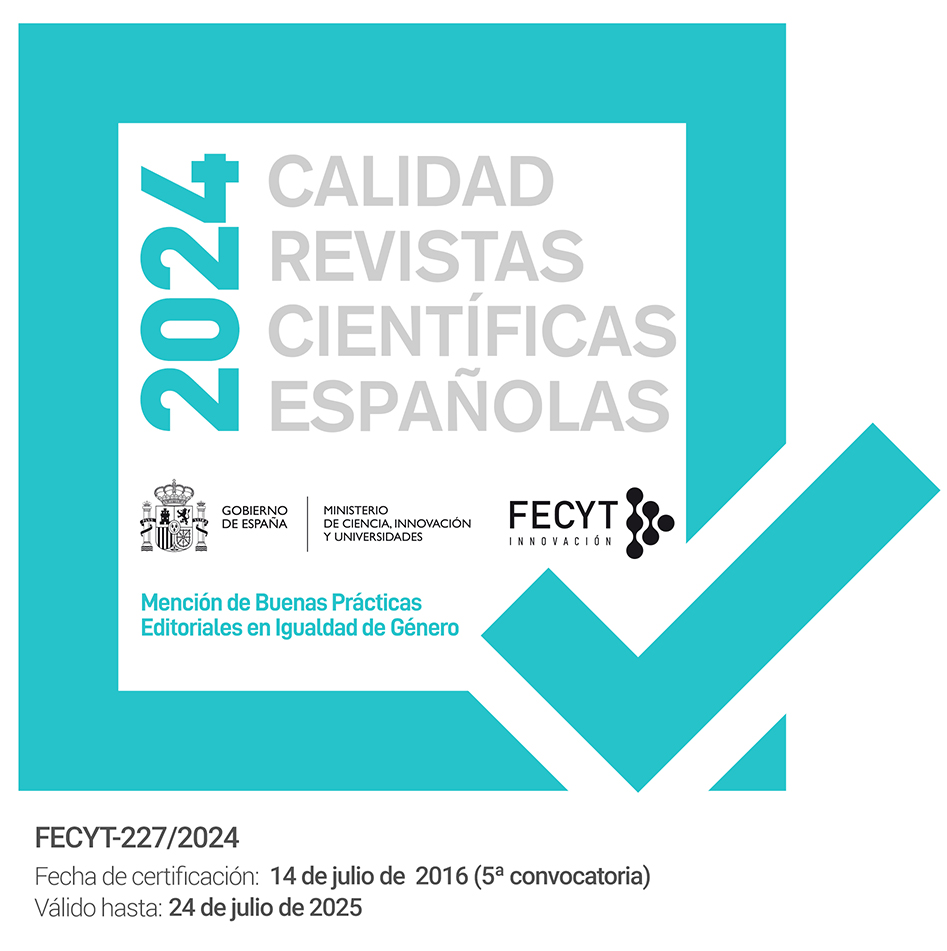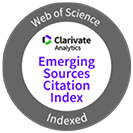Application of 3D printing technology for the pharmaceutical formulation of flavonoids
DOI:
https://doi.org/10.30827/ars.v66i2.31923Keywords:
Flavonoids, Three-Dimensional Printing, Drug CompoundingAbstract
Introduction: 3D printing is an advanced technology that can be used to formulate pharmaceutical compounds with low solubility, such as flavonoids—plant-derived compounds to which various pharmacological effects have been attributed. This review describes studies in which this technology has been applied to formulate flavonoids into different pharmaceutical forms.
Methodology: A bibliographic review was conducted by searching databases such as Google Scholar and PubMed search engine up to January 2025, using the keywords “3D printing,” “flavonoids,” and “formulation.” Original articles published in English were selected.
Results: Five articles were found. In these studies, the flavonoids puerarin, catechin, apigenin, and quercetin were formulated. Puerarin, a flavonoid with cardiovascular effects, was used in gastric floating tablets that extended its stomach retention time and improved its release compared to conventional tablets. For catechin and apigenin (flavonoids with antioxidant and anticancer properties, respectively), oral mucoadhesive films were designed, allowing rapid local absorption for the treatment of oral ulcers and leukoplakia, respectively. Quercetin, known for its antimicrobial activity against Mycobacterium tuberculosis, was formulated into dermal patches that achieved sustained drug release for 70 hours in in vitro studies and maintained stable plasma levels for up to 18 days in animal models.
Conclusion: 3D printing has been successfully used to formulate flavonoids into different pharmaceutical forms, significantly improving their biopharmaceutical properties. However, this is basic research, therefore, it is important to conduct formal preclinical trials to benefit real patients, including veterinary patients.
Downloads
References
Nabavi SM, Šamec D, Tomczyk M, Milella L, Russo D, Habtemariam S, et al. Flavonoid biosynthetic pathways in plants: Versatile targets for metabolic engineering. Biotechnol Adv. 2020; 38: 107316. Doi: 10.1016/j.biotechadv.2018.11.005. DOI: https://doi.org/10.1016/j.biotechadv.2018.11.005
Shaikh JR, Patil M. Qualitative tests for preliminary phytochemical screening: An overview. Int J Chem Stud. 2020; 8(2): 603–608. Doi: 10.22271/chemi.2020.v8.i2i.8834. DOI: https://doi.org/10.22271/chemi.2020.v8.i2i.8834
Kozłowska A, Szostak-Węgierek D. Flavonoids – Food Sources, Health Benefits, and Mechanisms Involved. 2018; 65(2):79–85.
Shen N, Wang T, Gan Q, Liu S, Wang L, Jin B. Plant flavonoids: Classification, distribution, biosynthesis, and antioxidant activity. Food Chem. 2022; 383: 132531. Doi: 10.1016/j.foodchem.2022.132531. DOI: https://doi.org/10.1016/j.foodchem.2022.132531
Terahara N. Flavonoids in Foods: A Review. Natural Products Communications. 2015; 10(3): 1934578X1501000334. Doi: 10.1177/1934578X15010003. DOI: https://doi.org/10.1177/1934578X1501000334
Roy A, Khan A, Ahmad I, Alghamdi S, Rajab BS, Babalghith AO, et al. Flavonoids a Bioactive Compound from Medicinal Plants and Its Therapeutic Applications. Biomed Res Int. 2022; 2022(1): 5445291. Doi: 10.1155/2022/5445291. DOI: https://doi.org/10.1155/2022/5445291
Jucá MM, Cysne Filho FMS, de Almeida JC, Mesquita D da S, Barriga JR de M, Dias KCF, et al. Flavonoids: biological activities and therapeutic potential. Nat Prod Res. 2018; 34(5): 692–705. Doi: 10.1080/14786419.2018.1493588. DOI: https://doi.org/10.1080/14786419.2018.1493588
Zhao J, Yang J, Xie Y. Improvement strategies for the oral bioavailability of poorly water-soluble flavonoids: An overview. Int J Pharm. 2019; 570: 118642. Doi: 10.1016/j.ijpharm.2019.118642. DOI: https://doi.org/10.1016/j.ijpharm.2019.118642
Gaikwad SS, Kshirsagar SJ. Review on Tablet in Tablet techniques. Beni-Suef Univ J Basic Appl Sci. 2020; 9(1): 1–7. Doi: 10.1186/s43088-019-0027-7. DOI: https://doi.org/10.1186/s43088-019-0027-7
Nagula RL, Wairkar S. Recent advances in topical delivery of flavonoids: A review. J Control Release. 2019; 296: 190–201. Doi: 10.1016/j.jconrel.2019.01.029. DOI: https://doi.org/10.1016/j.jconrel.2019.01.029
Yan Q, Dong H, Su J, Han J, Song B, Wei Q, et al. A Review of 3D Printing Technology for Medical Applications. Engineering. 2018; 4(5): 729–742. Doi: 10.1016/j.eng.2018.07.021. DOI: https://doi.org/10.1016/j.eng.2018.07.021
Prasad LK, Smyth H. 3D Printing technologies for drug delivery: a review. Drug Development and Industrial Pharmacy. 2015; 42(7):1019–1031. Doi: 10.3109/03639045.2015.1120743. DOI: https://doi.org/10.3109/03639045.2015.1120743
Wook Huh H, Na YG, Kang HC, Kim M, Han M, Mai Anh Pham T, et al. Novel self-floating tablet for enhanced oral bioavailability of metformin based on cellulose. Int J Pharm. 2021; 592: 120113. Doi: 10.1016/j.ijpharm.2020.120113. DOI: https://doi.org/10.1016/j.ijpharm.2020.120113
Jovanović M, Petrović M, Cvijić S, Tomić N, Stojanović D, Ibrić S, et al. 3D Printed Buccal Films for Prolonged-Release of Propranolol Hydrochloride: Development, Characterization and Bioavailability Prediction. Pharmaceutics. 2021; 13(12): 2143. Doi: 10.3390/pharmaceutics13122143. DOI: https://doi.org/10.3390/pharmaceutics13122143
Mohammed AA, Algahtani MS, Ahmad MZ, Ahmad J, Kotta S. 3D Printing in medicine: Technology overview and drug delivery applications. Ann 3D Print Med. 2021; 4: 100037. Doi: 10.1016/j.stlm.2021.100037. DOI: https://doi.org/10.1016/j.stlm.2021.100037
Li P, Zhang S, Sun W, Cui M, Wen H, Li Q, et al. Flexibility of 3D Extruded Printing for a Novel Controlled-Release Puerarin Gastric Floating Tablet: Design of Internal Structure. AAPS PharmSciTech. 2019; 20(6): 236. Doi: 10.1208/s12249-019-1455-3. DOI: https://doi.org/10.1208/s12249-019-1455-3
Li Q, Guan X, Cui M, Zhu Z, Chen K, Wen H, et al. Preparation and investigation of novel gastro-floating tablets with 3D extrusion-based printing. Int J Pharm. 2018; 535(1–2): 325–332. Doi: 10.1016/j.ijpharm.2017.10.037. DOI: https://doi.org/10.1016/j.ijpharm.2017.10.037
Seoane-Viaño I, Januskaite P, Alvarez-Lorenzo C, Basit AW, Goyanes A. Semi-solid extrusion 3D printing in drug delivery and biomedicine: Personalised solutions for healthcare challenges. J Control Release. 2021; 332. Doi: 10.1016/j.jconrel.2021.02.027. DOI: https://doi.org/10.1016/j.jconrel.2021.02.027
Karavasili C, Eleftheriadis GK, Gioumouxouzis C, Andriotis EG, Fatouros DG. Mucosal drug delivery and 3D printing technologies: A focus on special patient populations. Adv Drug Deliv Rev. 2021;176: 113858. Doi: 10.1016/j.addr.2021.113858. DOI: https://doi.org/10.1016/j.addr.2021.113858
Dumpa N, Butreddy A, Wang H, Komanduri N, Bandari S, Repka MA. 3D printing in personalized drug delivery: An overview of hot-melt extrusion-based fused deposition modeling. Int J Pharm. 2021; 600: 120501. Doi: 10.1016/j.ijpharm.2021.120501. DOI: https://doi.org/10.1016/j.ijpharm.2021.120501
Tan DK, Maniruzzaman M, Nokhodchi A. Advanced Pharmaceutical Applications of Hot-Melt Extrusion Coupled with Fused Deposition Modelling (FDM) 3D Printing for Personalised Drug Delivery. Pharm. 2018; 10(4): 203. Doi: doi.org/10.3390/pharmaceutics10040203. DOI: https://doi.org/10.3390/pharmaceutics10040203
Shi X, Fan N, Zhang G, Sun J, He Z, Li J. Quercetin amorphous solid dispersions prepared by hot melt extrusion with enhanced solubility and intestinal absorption. Pharm Dev Technol. 2020; 25(4): 472–481. Doi: 10.1080/10837450.2019.1709502. DOI: https://doi.org/10.1080/10837450.2019.1709502
Adnan M, Azad MOK, Ju HS, Son JM, Park CH, Shin MH, et al. Development of biopolymer-mediated nanocomposites using hot-melt extrusion to enhance the bio-accessibility and antioxidant capacity of kenaf seed flour. Appl Nanosci. 2020; 10(4): 1305–1317. Doi: 10.1007/s13204-019-01205-z. DOI: https://doi.org/10.1007/s13204-019-01205-z
Deshkar S, Rathi M, Zambad S, Gandhi K. Hot Melt Extrusion and its Application in 3D Printing of Pharmaceuticals. Curr Drug Deliv. 2021; 18(4): 387–407. Doi: 10.2174/1567201817999201110193655. DOI: https://doi.org/10.2174/1567201817999201110193655
Li P, Jia H, Zhang S, Yang Y, Sun H, Wang H, et al. Thermal Extrusion 3D Printing for the Fabrication of Puerarin Immediate-Release Tablets. AAPS PharmSciTech. 2020; 21(1): 20. Doi: 10.1208/s12249-019-1538-1. DOI: https://doi.org/10.1208/s12249-019-1538-1
Tagami T, Yoshimura N, Goto E, Noda T, Ozeki T. Fabrication of muco-adhesive oral films by the 3D printing of hydroxypropyl methylcellulose-based catechin-loaded formulations. Biol Pharm Bull. 2019; 42(11): 1898–1905. Doi: 10.1248/bpb.b19-00481. DOI: https://doi.org/10.1248/bpb.b19-00481
Takashima H, Tagami T, Kato S, Pae H, Ozeki T, Shibuya Y. Three-Dimensional Printing of an Apigenin-Loaded Mucoadhesive Film for Tailored Therapy to Oral Leukoplakia and the Chemopreventive Effect on a Rat Model of Oral Carcinogenesis. Pharmaceutics. 2022; 14(8): 1575. Doi: 10.3390/pharmaceutics14081575. DOI: https://doi.org/10.3390/pharmaceutics14081575
Alali AS, Muqtader Ahmed M, Fatima F, Anwer MK, Ibnauf M, Aboudzadeh MA. Chitosan-based spray-dried solid dispersions of apigenin in a 3D printable drug delivery system. J Appl Polym Sci. 2025; 142(1):e56310. Doi: 10.1002/app.56310. DOI: https://doi.org/10.1002/app.56310
Chaudhari VS, Malakar TK, Murty US, Banerjee S. Extruded filaments derived 3D printed medicated skin patch to mitigate destructive pulmonary tuberculosis: design to delivery. Expert Opin Drug Deliv. 2021; 18(2): 301–313. Doi: 10.1080/17425247.2021.1845648. DOI: https://doi.org/10.1080/17425247.2021.1845648
Flora GD, Nayak MK. A Brief Review of Cardiovascular Diseases, Associated Risk Factors and Current Treatment Regimes. Curr Pharm Des. 2019; 25(38): 4063–4084. Doi: 10.2174/1381612825666190925163827. DOI: https://doi.org/10.2174/1381612825666190925163827
Jiang Z, Cui X, Qu P, Shang C, Xiang M, Wang J. Roles and mechanisms of puerarin on cardiovascular disease: A review. Biomed Pharmacother. 2022; 147: 112655. Doi: 10.1016/j.biopha.2022.112655. DOI: https://doi.org/10.1016/j.biopha.2022.112655
Huang M, Long L, Deng M, Yu Z, Qu H, Tan L, et al. Effectiveness and safety of Yufeng Ningxin for the treatment of essential hypertension: A protocol for systematic review and meta-analysis. Medicine (Baltimore). 2021; 100(9): e24858. Doi: 10.1097/MD.0000000000024858. DOI: https://doi.org/10.1097/MD.0000000000024858
Joshi HN, Tejwani RW, Davidovich M, Sahasrabudhe VP, Jemal M, Bathala MS, et al. Bioavailability enhancement of a poorly water-soluble drug by solid dispersion in polyethylene glycol-polysorbate 80 mixture. Int J Pharm. 2004; 269:251–258. Doi: 10.1016/j.ijpharm.2003.09.002. DOI: https://doi.org/10.1016/j.ijpharm.2003.09.002
Sheen PC, Khetarpal VK, Cariola CM, Rowlings CE. Formulation studies of a poorly water-soluble drug in solid dispersions to improve bioavailability. Int J Pharm. 1995; 118(2): 221–227. Doi: 10.1016/0378-5173(94)00366-D. DOI: https://doi.org/10.1016/0378-5173(94)00366-D
Gadkari PV, Balaraman M. Catechins: Sources, extraction and encapsulation: A review. Food Bioprod Process. 2015; 93: 122–138. Doi: 10.1016/j.fbp.2013.12.004. DOI: https://doi.org/10.1016/j.fbp.2013.12.004
Salehi B, Venditti A, Sharifi-Rad M, Kręgiel D, Sharifi-Rad J, Durazzo A, et al. The therapeutic potential of Apigenin. International Journal of Molecular Sciences. Multidisciplinary Digital Publishing Institute. 2019; 20(6): 1305. Doi: 10.3390/ijms20061305. DOI: https://doi.org/10.3390/ijms20061305
Jang JY, Sung B, Kim ND. Role of Induced Programmed Cell Death in the Chemopreventive Potential of Apigenin. Int J Mol Sci. 2022; 23(7): 3757. Doi: 10.3390/ijms23073757. DOI: https://doi.org/10.3390/ijms23073757
Lyon SM, Rossman MD. Pulmonary Tuberculosis. 2017; 5(1): 10-1128. Doi: 10.1128/microbiolspec.tnmi7-0032-2016. DOI: https://doi.org/10.1128/microbiolspec.TNMI7-0032-2016
Giller DB, Giller BD, Giller GV, Shcherbakova GV, Bizhanov AB, Enilenis II, et al. Treatment of pulmonary tuberculosis: past and present. Eur J Cardio-Thoracic Surg. 2018; 53(5): 967–972. Doi: 10.1093/ejcts/ezx447. DOI: https://doi.org/10.1093/ejcts/ezx447
Hussain A, Altamimi MA, Alshehri S, Imam SS, Shakeel F, Singh SK. Novel approach for transdermal delivery of rifampicin to induce synergistic antimycobacterial effects against cutaneous and systemic tuberculosis using a cationic nanoemulsion gel. Int J Nanomedicine. 2020; 15: 1073–1094. Doi: 10.2147/IJN.S236277. DOI: https://doi.org/10.2147/IJN.S236277
Kandemir K, Tomas M, McClements DJ, Capanoglu E. Recent advances on the improvement of quercetin bioavailability. Trends Food Sci Technol. 2022; 119: 192–200. Doi: 10.1016/j.tifs.2021.11.032. DOI: https://doi.org/10.1016/j.tifs.2021.11.032
Wang W, Sun C, Mao L, Ma P, Liu F, Yang J, et al. The biological activities, chemical stability, metabolism and delivery systems of quercetin: A review. Trends Food Sci Technol. 2016; 56: 21–38. Doi: 10.1016/j.tifs.2016.07.004. DOI: https://doi.org/10.1016/j.tifs.2016.07.004
Butov DO, Zaitseva SI, Pitenko MM, Stepanenko GL, Butova TS. Morphological changes in experimental tuberculosis resulting from treatment with quercetin and polyvinylpyrrolidone. Int J Mycobacteriology. 2015; 4(4): 296–301. Doi: 10.1016/j.ijmyco.2015.08.003. DOI: https://doi.org/10.1016/j.ijmyco.2015.08.003
Sasikumar K, Ghosh AR, Dusthackeer A. Antimycobacterial potentials of quercetin and rutin against Mycobacterium tuberculosis H37Rv. 3 Biotech. 2018; 8(10): 427. Doi: 10.1007/s13205-018-1450-5. DOI: https://doi.org/10.1007/s13205-018-1450-5
Butov D, Zaitseva S, Butova T, Stepanenko G, Pogorelova O, Zhelezniakova N. Efficacy and safety of quercetin and polyvinylpyrrolidone in treatment of patients with newly diagnosed destructive pulmonary tuberculosis in comparison with standard antimycobacterial therapy. Int J Mycobacteriology. 2016; 5(4): 446–453. Doi: 10.1016/j.ijmyco.2016.06.012. DOI: https://doi.org/10.1016/j.ijmyco.2016.06.012
Lehmkemper K, Kyeremateng SO, Heinzerling O, Degenhardt M, Sadowski G. Long-Term Physical Stability of PVP- and PVPVA-Amorphous Solid Dispersions. Mol Pharm. 2017; 14(1): 157–171. Doi: 10.1021/acs.molpharmaceut.6b00763. DOI: https://doi.org/10.1021/acs.molpharmaceut.6b00763
Dos Santos J, da Silva GS, Velho MC, Beck RCR. Eudragit®: A Versatile Family of Polymers for Hot Melt Extrusion and 3D Printing Processes in Pharmaceutics. Pharmaceutics. 2021; 13(9): 1424. Doi: 10.3390/pharmaceutics13091424. DOI: https://doi.org/10.3390/pharmaceutics13091424
Agrawal AM, Dudhedia MS, Zimny E. Hot Melt Extrusion: Development of an Amorphous Solid Dispersion for an Insoluble Drug from Mini-scale to Clinical Scale. AAPS PharmSciTech. 2016; 17(1): 133–147. Doi: 10.1208/s12249-015-0425-7. DOI: https://doi.org/10.1208/s12249-015-0425-7
Tracy T, Cheng S, Wu L, Liu X, Li X. Enhancing Oral Bioavailability Using 3D Printing Technology. Oral Bioavailab Drug Deliv. 2023; 657–676. Doi: 10.1002/9781119660699.ch34. DOI: https://doi.org/10.1002/9781119660699.ch34
Shaikh R, Raj Singh T, Garland M, Woolfson A, Donnelly R. Mucoadhesive drug delivery systems. J Pharm Bioallied Sci. 2011; 3(1): 89–100. Doi: 10.4103/0975-7406.76478. DOI: https://doi.org/10.4103/0975-7406.76478
Bird D, Ravindra NM. Transdermal drug delivery and patches—An overview. Med Devices Sensors. 2020; 3(6): e10069. Doi: 10.1002/mds3.10069. DOI: https://doi.org/10.1002/mds3.10069
Vicente E, Pruneda L, Ardanaz E. Paradox of rarity: about the percentage of population affected by rare diseases. Gac Sanit. 2020; 34(6): 536–538. Doi: 10.1016/j.gaceta.2020.02.012. DOI: https://doi.org/10.1016/j.gaceta.2020.02.012
Khan H, Ullah H, Tundis R, Belwal T, Devkota HP, Daglia M, et al. Dietary Flavonoids in the Management of Huntington’s Disease: Mechanism and Clinical Perspective. eFood. 2020; 1(1): 38–52. Doi: 10.2991/efood.k.200203.001. DOI: https://doi.org/10.2991/efood.k.200203.001
Deep A, Marwaha RK, Marwaha MG, Jyoti, Nandal R, Sharma AK. Flavopiridol as cyclin dependent kinase (CDK) inhibitor: a review. New J Chem. 2018; 42(23): 18500–18507. Doi: 10.1039/C8NJ04306J. DOI: https://doi.org/10.1039/C8NJ04306J
Saydam M, Takka S. Improving the dissolution of a water-insoluble orphan drug through a fused deposition modelling 3-Dimensional printing technology approach. Eur J Pharm Sci. 2020; 152: 105426. Doi: 10.1016/j.ejps.2020.105426. DOI: https://doi.org/10.1016/j.ejps.2020.105426
Sjöholm E, Mathiyalagan R, Wang X, Sandler N. Compounding Tailored Veterinary Chewable Tablets Close to the Point-of-Care by Means of 3D Printing. Pharmaceutics. 2022; 14(7): 1339. Doi: 10.3390/pharmaceutics14071339. DOI: https://doi.org/10.3390/pharmaceutics14071339
Sjöholm E, Mathiyalagan R, Prakash DR, Lindfors L, Wang Q, Wang X, et al. 3D-Printed Veterinary Dosage Forms—A Comparative Study of Three Semi-Solid Extrusion 3D Printers. Pharmaceutics. 2020; 12(12): 1239. Doi: 10.3390/pharmaceutics12121239. DOI: https://doi.org/10.3390/pharmaceutics12121239
Scott KA, Qureshi MH, Cox PB, Marshall CM, Bellaire BC, Wilcox M, et al. A Structural Analysis of the FDA Green Book-Approved Veterinary Drugs and Roles in Human Medicine. 2020; 63(24): 15449-15482. Doi: 10.1021/acs.jmedchem.0c01502. DOI: https://doi.org/10.1021/acs.jmedchem.0c01502
Karancsi Z, Balázs A, Gálfi P, Farkas O. Flavonoids - new perspectives in the veterinary medicine. Magy Állatorvosok Lapja. 2015; 137(11): 695–704.
Khan D, Kirby D, Bryson S, Shah M, Rahman Mohammed A. Paediatric specific dosage forms: Patient and formulation considerations. Int J Pharm. 2022; 616: 121501. Doi: 10.1016/j.ijpharm.2022.121501 DOI: https://doi.org/10.1016/j.ijpharm.2022.121501
McCloskey AP, Bracken L, Vasey N, Ehtezazi T. 3D printing – an alternative strategy for pediatric medicines. Expert Rev Clin Pharmacol. 2023; 16(7): 613–6. Doi: 10.1080/17512433.2023.2233416 DOI: https://doi.org/10.1080/17512433.2023.2233416
Russi L, Del Gaudio C. 3D printed multicompartmental capsules for a progressive drug release. Ann 3D Print Med. 2021; 3: 100026. Doi: 10.1016/j.stlm.2021.100026. DOI: https://doi.org/10.1016/j.stlm.2021.100026
Awad A, Hollis E, Goyanes A, Orlu M, Gaisford S, Basit AW. 3D printed multi-drug-loaded suppositories for acute severe ulcerative colitis. Int J Pharm X. 2023; 5: 100165. Doi: 10.1016/j.ijpx.2023.100165. DOI: https://doi.org/10.1016/j.ijpx.2023.100165
Zhu C, Tian Y, Zhang E, Gao X, Zhang H, Liu N, et al. Semisolid Extrusion 3D Printing of Propranolol Hydrochloride Gummy Chewable Tablets: an Innovative Approach to Prepare Personalized Medicine for Pediatrics. AAPS PharmSciTech. 2022; 23(5): 166. Doi: 10.1208/s12249-022-02304-x. DOI: https://doi.org/10.1208/s12249-022-02304-x
Downloads
Published
How to Cite
Issue
Section
License
Copyright (c) 2025 Ivo Heyerdahl-Viau

This work is licensed under a Creative Commons Attribution-NonCommercial-ShareAlike 4.0 International License.
The articles, which are published in this journal, are subject to the following terms in relation to the rights of patrimonial or exploitation:
- The authors will keep their copyright and guarantee to the journal the right of first publication of their work, which will be distributed with a Creative Commons BY-NC-SA 4.0 license that allows third parties to reuse the work whenever its author, quote the original source and do not make commercial use of it.
b. The authors may adopt other non-exclusive licensing agreements for the distribution of the published version of the work (e.g., deposit it in an institutional telematic file or publish it in a monographic volume) provided that the original source of its publication is indicated.
c. Authors are allowed and advised to disseminate their work through the Internet (e.g. in institutional repositories or on their website) before and during the submission process, which can produce interesting exchanges and increase citations of the published work. (See The effect of open access).























